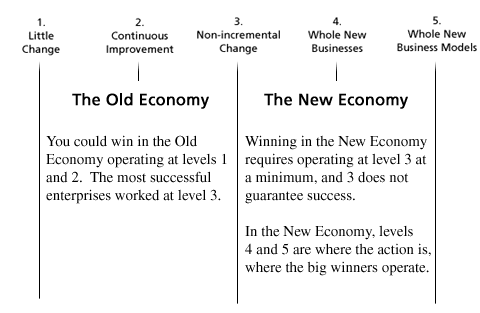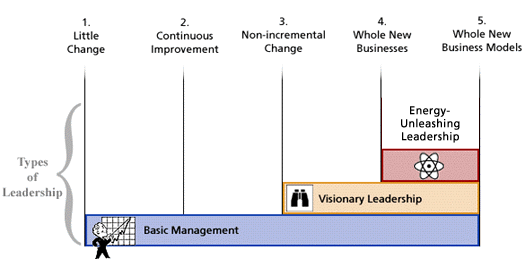In this fast paced era of knowledge, a new means of exchanging ideas is necessary in order for us all to have access to the newest concepts and to have a timely dialogue about them. Promising ideas need to be disseminated, discussed and integrated rapidly. In "Leading in the 21st Century," John Kotter attempts to do just this. He presents you with new thoughts and ideas on leadership in a new era—ideas normally not available until they appear in book or article form. Here they are presented in raw form. We hope you will join others in a dialogue about these ideas and comment as often as you wish in each of the different sections.
5 Degrees of Change
Different industries operate at different levels of change and thus need to use different approaches to succeed. Read through the 5 degrees of change listed below, then continue on to see how the degrees of change relate to different types of leadership and winning in the new economy.
1. |
Little change |
2. |
Continuous
improvement |
3. |
Non-incremental
change within businesses |
4. |
Whole new
businesses |
5. |
Whole new business
models |
5 Degrees of Change: Leadership and Change
This chart shows the types of leadership necessary to operate at the "5 Degrees of Change." As you can see, using Energy-Unleashing Leadership does not mean you can abandon Basic Management or Visionary Leadership. To operate at the highest degrees of change, an effective combination of all three is needed.
|
Excellent Basic Management |
|
Visonary Leadership |
|
Energy-Unleashing Leadership |
|
5 Degrees of Change: Winning in the New Economy
This chart shows the relation of enterprise performance in the Old and New Economies to the "5 Degrees of Change." As you can see, it takes a lot more to win in the New Economy than in the Old.

Energy-Unleashing Leadership
|
|||||||||||||||||||||||||||||||||||||||
The Evolution of Leadership and Enterprise Performance

In 1975, Visionary Leadership is the central driving force, not the only driving force, of firms operating at an astonishing level of performance. For example, when it has worked well in the past, Visionary Leadership has been supplemented by basic management.
In 2015, Over-management is missing in the new economy because it puts organizations out of business, and terrible performance is missing because it will rarely be tolerated by customers. Visionary leadership performs less well because great alignment can stifle the massive innovation needed in the new economy. Also, motivated people are not motivated enough to produce the energy needed to move at the speed of the new economy.
Winning and Losing in the Old and New Economies
Winning in the Old Economy |
||
Enterprise's Goal |
Type of Leadership |
|
Traditional Business |
Efficiency |
Good Management |
New Business |
Avoid fundamentally new businesses because of the risks involved |
|
Losing Today |
||
Enterprise's Goal |
Type of Leadership |
|
Traditional Business |
Maintaining historical financial returns |
Over-management which tries to force the achievement of increasingly impossible goals |
New Business |
Efficiency, which usually means immediate financial returns for new investments |
Basic competent management |
Winning Today |
||
Enterprise's Goal |
Type of Leadership |
|
Traditional Business |
Adapting to significant changes in the market for traditional products and services |
Visionary/Transformational Leadership |
New Business |
Adapting to significant changes in the marketplace |
Visionary/Transformational Leadership |
Winning in the New Economy |
||
Enterprise's Goal |
Type of Leadership |
|
Traditional Business |
Adapting to significant changes in the market for traditional products and services |
Visionary/Transformational Leadership |
New Business |
Leaping beyond today's frontiers |
Energy-Unleashing Leadership |
Speed, Leadership, and Performance
20 miles per hour industry |
70 miles per hour industry |
150 miles per hour industry |
|
Key Factor in a Firm Performing with Excellence |
Good management |
Visionary/ |
Energy-unleashing leadership, visionary leadership, and good management. Seeing far ahead is less possible. Maneuverability and horsepower are essential. |
What is needed to go from so-so to excellent |
An infusion of some visionary/ |
A strong infusion of visionary leadership. After ‘improvement,’ leadership must be institutionalized. |
An infusion of more visionary leadership and energy-unleashing leadership. Both must eventually be institutionalized unless industry slows down. |
A firm performing so-so |
So-so management |
So-so visionary leadership and management. |
Only good management and good visionary leadership. |
More Early Thoughts on Leadership
|
|
Think in terms of market-oriented visions and strategies; Look broadly around their domains and are willing to challenge the status quo; Work with others to create guiding elements for the group or enterprise, despite the difficulties in doing so; Understand that a vision is not a plan, that a strategy is more than numbers; Even at lower levels in organizations, they set clear direction by generating visions/strategies relevant to their areas of responsibility. |
Fight past the cynicism and fear inside themselves to find their hopes, dreams, and childhood ideals; Help other people do the same, mostly through leader role modeling, even though that makes them vulnerable to criticism from "realistic" colleagues; Use the passion and creative power that is released from these actions to shape exceptionally bold group goals; When ideals are involved, just "good" is never good enough, and that attitude affects all visions and strategies. |
|
|
Believe in and seek teamwork by constantly communicating visions and strategies; Communicate both with words and with their actions, and do so day after day and week after week; No meeting ends without some reference to longer-term goals; Often escape their offices to deliver messages face-to-face and to role model the teamwork they need. |
Refuse to accept any parochial or self indulgent behavior; "Do what is right" is the guiding principal, and it’s created by appealing to very basic human values, by appealing to that which we share regardless of educational background, nationality, religion, or race: a desire for security for self and family, for love, for respect, for opportunities to grow, for a sense of purpose in one’s life; The talk goes beyond what we do (strategies) or how we do things (rules) to who we are. |
|
|
Motivate action with positive incentives of all sorts: a pat on the back, public recognition, extra money in the paycheck; Tend to attack, sometimes courageously, that which can de-motivate employees, no matter the source; Dealing with these leaders, one senses the enthusiasm, even from introverted individuals; Working with them is exciting! |
Help people unleash untapped energies in pursuit of the tough group goals. They do so, partially, by creating work that has true meaning, work that speaks to a deep level inside individuals, to that which some would call spiritual; The tenor of the conversation seems to always address the unasked (and very difficult) questions of: so what?; why are we here?; what difference does this make?; what difference can we make?; what difference should we make? |






